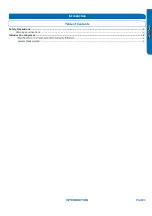
INTRODUCTION
PAGE 5
Introduction to System
Single Zone Ductless Split System Heat Pumps feature a wall
mounted indoor fan/evaporator unit that receives refrigerant
from an inverter driven variable speed outdoor condensing
unit. The system operation is controlled with a remote
control.
The outdoor unit features a variable speed rotary
compressor, EEV metering device and DC fan motor. These
systems use R410A refrigerant and PVE oil. The outdoor units
are 208/230 volt rated systems. They come factory charged
●
for up to 25 ft. of interconnecting piping.
The indoor units are wall mounted. They feature a DC
blower motor and a DC louver motor. The unit has a room
●
temperature sensor and an evaporator tube temperature
sensor. The wall unit is powered by voltage from the outdoor
unit.
ranges of 60°F to 86°F in cooling mode and 60°F to 86°F in
heat mode.
hydrolysis. There is no need to add a refrigeration drier
●
when servicing or installing this system.
and communication data signals on #14 AWG wire that
●
connects between the indoor and outdoor units. There
●
between terminals 1, 2, 3 and 4. A splice in these wires may
cause the system to lose communication between the
indoor and outdoor units. The system will then display an
error code E7.
insulated. The only method of checking charge or adjusting
charge is by weight method explained in this manual (no
exceptions).
condensate pump may be added to the system. Always
follow the manufacturer’s installation instructions when
installing a condensate pump.
maintained. Improper clearances cause incorrect refrigerant
pressures and coil freezing.
System Fundamentals
The indoor unit will sense room temperature at the point
where the wall unit is installed. The indoor fan will run
continuously when placed in heating or cooling mode
room temperature could not be sensed or maintained.
Introduction
The inverter compressor system in the outdoor unit will vary
the comfort requirement inside the conditioned space. If an
abnormal condition is detected by the system’s sensors, the
system has the ability to take reactive measures.
generated by the system will be determined by how fast the
system’s variable speed rotary compressor is pumping. The
compressor operating speed is determined by
and the set point
If a large amount of capacity is needed, the compressor will
operate at a high speed. As the need for capacity
reduces and the temperature of the room nears set point,
the compressor will slow down. When set point has been
is sensed between the set point and room, the compressor
will restart at a new calculated speed.
If a system sensor determines there is a need to adjust
the frequency signal to prevent a system malfunction,
the compressor frequency may be over ridden and a new
frequency established. It should be noted that the frequency
signal level that is sent to the compressor cannot be
determined by a servicing technician.
In this manual, system components, operation, sensor
functions, and diagnostic procedures will be explained in
greater detail.
Summary of Contents for AW09EH2VHD
Page 2: ... This page intentionally left blank ...
Page 4: ...Failure to follow any CAUTION may in some cases result in grave consequences ...
Page 6: ...PAGE 6 ...
Page 9: ...5VDC and 15VDC pulsing communication connection between the PCB and the IPM ...
Page 10: ......
Page 11: ......
Page 12: ......
Page 13: ......
Page 14: ......
Page 15: ...Connector for coil temperature sensor and room temperature sensor ...
Page 17: ......
Page 19: ......
Page 22: ......
Page 23: ......
Page 26: ...PAGE 32 ...
Page 50: ...Error Code E7 LED1 15 Flash Wiring Diagram Reference PAGE 50 ERROR CODES and Troubleshooting ...
Page 57: ...PAGE 57 Ambient Defrost and Pipe Sensor Tables Discharge Sensor Tables ...






































